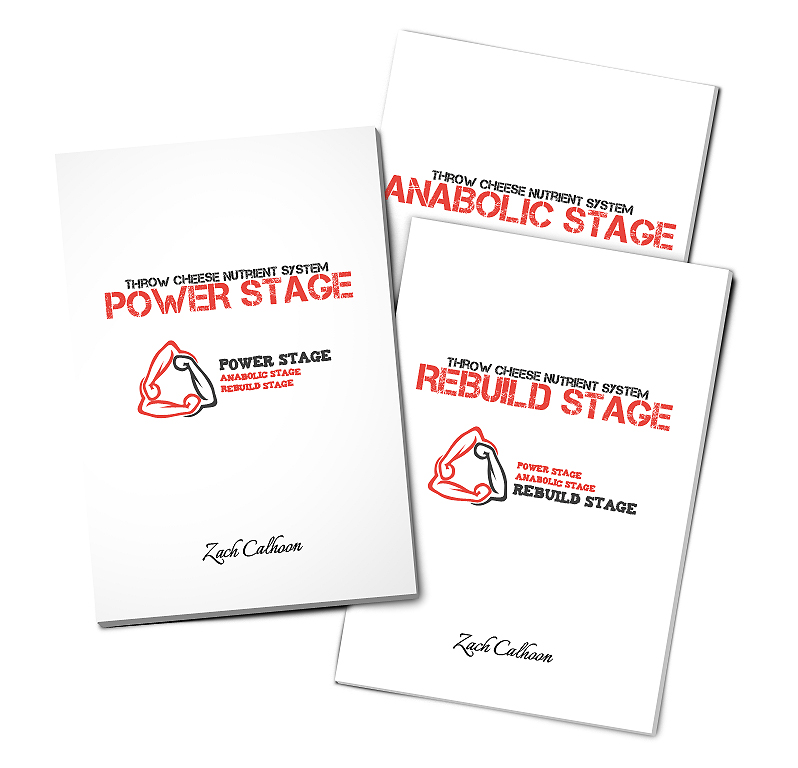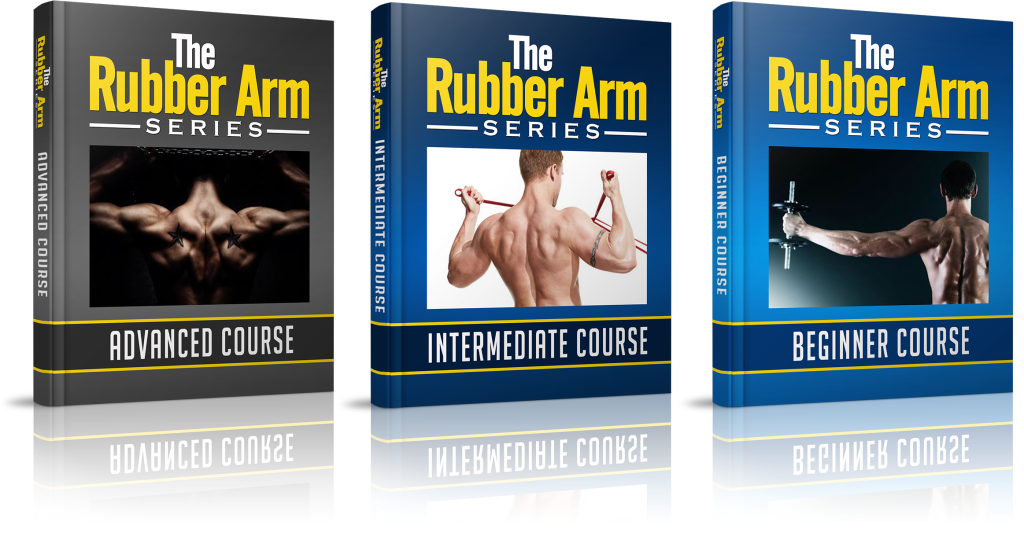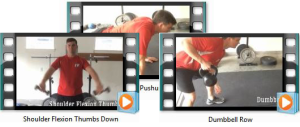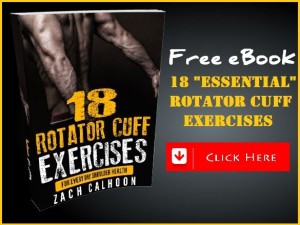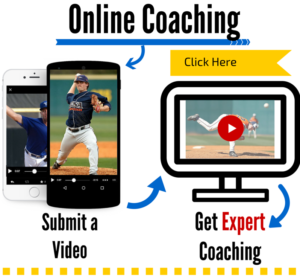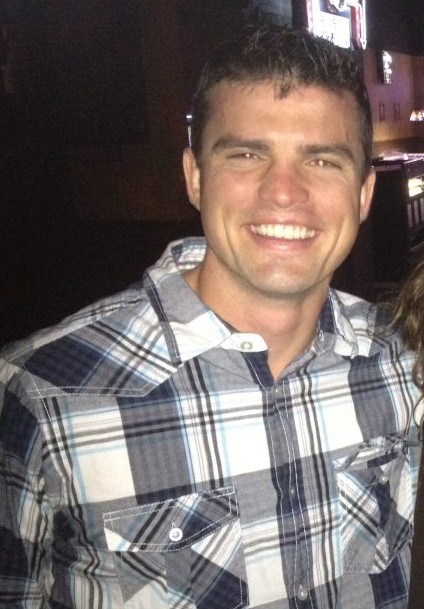
“Hi I am Zach Calhoon. My mission is to build healthy, elite, power pitchers based on proven science and first hand experience. Welcome to my lab. Here I peel back the curtain for what it really takes to throw 95 MPH. Just like I did. Spread the message, join the mission, lets throw cheese. I can’t wait to hear about your success.” -Zach
What is PitchersThrowCheese.com?
Pitchers Throw Cheese philosophy of pitcher training is based on 5 key elements of training. Which will will touch on right now. This philosophy is called the “The 5 Pillars Of Velocity”

Even though there is many different ideas and theories of velocity training. My team and I, will give you exactly the process I used to throw 95 MPH. You may not agree with some of these theories of training, but you will get insight to consider. By the end of this article , you will know where to focus your training. Read through these points. Know them well.
Velocity Pillar 1 – Strong Legs and Core.
 Lift Heavy and Lift Functionally
Lift Heavy and Lift Functionally
Here is what you need to throw fast.
- You will need very strong legs, the stronger the better.
- While maintaining flexibility (discussed later)
- Particularly 4 primary moves to gain velocity strength in your legs – back squat, front squat, RDL and lunges
- There is a difference between explosive functional strength and heavy lifting strength, you need both
- The lunge is a functional pitching movement. The squat builds the foundation of leg strength
- You can measure leg strength. Which also has a direct correlation to body weight. The more muscle mass you gain in your legs, the faster you will gain body weight. It’s a natural response.
- Remember your goal is not to just gain weight, but to gain strength. Fat pitchers can throw hard, but you don’t have to be fat to throw fast.
- So you need to accomplish these moves at a heavy weight each week.
- If you read fastball muscle you are aware of “progressive muscle overload” theory
- After you lift heavy legs there is some important recovery tools to consider.
- 1) You need to stretch your hamstrings and hips after each workout. If you do this, you will recover faster, and you will maintain the functional mobility needed to pitch a baseball. Also you need to push your hip and shoulder separation at this time. You will be the most loose and warm right then. You have to push for flexibility right away.
- 2) You need to consume a ton of fast calories. Right after you lift a heavy legs set, you are primed for muscle growth. This will have an immediate effect on your fastball velocity.
- You are required to do heavy twisting med ball punch throws. This is an awkward move and I had a wall to throw a heavy rubber ball into. Not everyone has this option to throw a heavy med ball. But if you do, its one of the most functional pitching moves you can accomplish. I am not talking about an overhead throw. Twisting medicine ball punch along with reverse throws are very beneficial.
- You will be required to complete a heavy core routine at least twice a week. I understand that 8 minutes abs is popular. But you need heavy strength. That means you need to add weight. There is more benefit adding weight to core movements. For example. Grab a 25 pound plate and do seated twist. As you get stronger, add a heavier plate. Same thing for sit-ups and same thing for bridge core type moves. You need to progressively add weight. Remember progressive overload from fastball muscle, this theory still applies to your core strength.
- Should you be lifting upper body as a pitcher?
- Here is the deal, this so controversial in training circles for pitchers. All of you are different. Here is what I did. You do what you want. But I am going to tell you exactly what I did and what I avoided.
- I wanted a huge strong back, and you should too. That means you need to have a 1 arm dumbbell row that is north of 60 pounds for 3 sets of 10. I know some of you are younger. But as you build this big part of your back you will be able to handle such a higher throwing load later on. You need to also be able to do pull ups or pull up type row movements. This builds your lats and they are a big help for throwing. For velocity and for deceleration of each throw.
- Avoid chest. Check it out, I never did bench press. Not one time. It didn’t help me and it put extra stress on my rotator cuff. So I say, don’t do it. You don’t need it. I never did and I threw 95 MPH.
- Never do military press. Ever. Military press overhead, is a sure fire way to slow down your fastball. If you currently do it, stop.
- There is a lot of back muscles that can be developed and you need to cultivate a very strong back. This way, you can handle the throwing routine I will ask you to accomplish.
Velocity Pillar 2 – An Exact High Volume Throwing Program
- Throw everyday. Yep, every single day. I know this will sound crazy. But injury do not come from over usage. Injuires come from weakness and bad mechanics. Not throwing to often. Just look at the MLB. They play 162 games. And they are fine. I think, because throwing is good for your arm. It has to be the number 1 priorty for all your training. Each day, I threw first, and did all other training after that.
- Long toss. This is obvious to most pitchers but I will still say it. Make sure you are long tossing 2 to 3 times a week. At max effort. This is something you can measure. Rest days are in between. Yet you should still throw on these “off” days. If you want to throw 95, you should be able to throw the ball at least 300 feet. Essentially find a football field. Make it your goal to reach the goal post. Yes, it is possible.
- So what about when your arm is tired? Still throw a small amount. Go through your entire routine to get loose. Then just throw a small amount. You will wake up your muscle and nerves and actually recover faster. This seems counter intuitive, but once you try it. You will understand. Your arm is unquie. You need to treat it correctly, but do not baby it.
- How many bullpens a week. I would do 2 bullpens a week. One extended session and one short session. Every day I could, I would do flat work in-between.
Velocity Pillar 3 – Flexibility and Mobility
- Because I recommend lifting, heavy and often, there is a key element to consider. How flexible are you? Can you touch your toes? If not you need to be able to. How flexible is your groin? If not very, you need to work on it. Also you need to always push your hips to be loose. This means stretching and mobility work.
- Yes certain people are naturally very flexible, but as you lift and get stronger you will lose some of that natural mobility. It is very important to keep pushing and stretching.
- Top places you need to be flexible
- Hamstrings
- Hips
- IT bands – side of legs
- Groin
- Internal rotation of the shoulder
- Lats
- Posterior cuff of your shoulder
- Here is how you accomplish mobility in these areas: You must spend a lot of time stretching these areas. Mobility is a cumulative response to your activity. In other words, the more time you spend trying to touch your toes with straight legs, the more likely you will achieve hamstring flexibility. It takes time. But anyone can do it.
- Example: 5 minutes every hour. Or 30 minutes before bed. Or the best option – right after you training session.
- I had an exact stretching routine I did every single time before I threw. I wouldn’t throw unless I went through the entire routine. I made my throwing partner wait. They would hate it, but I knew it was the right thing, so I stuck with it. You need an exact warm up routine. And you need to ALWAYS do it before you throw.
- Also after you lift, is “prime time” to push for added mobility. Your muscles fully warm is when you need to push them to gain flexibility.
Velocity Pillar 4 – An Elite Athlete Sports Nutrition Program
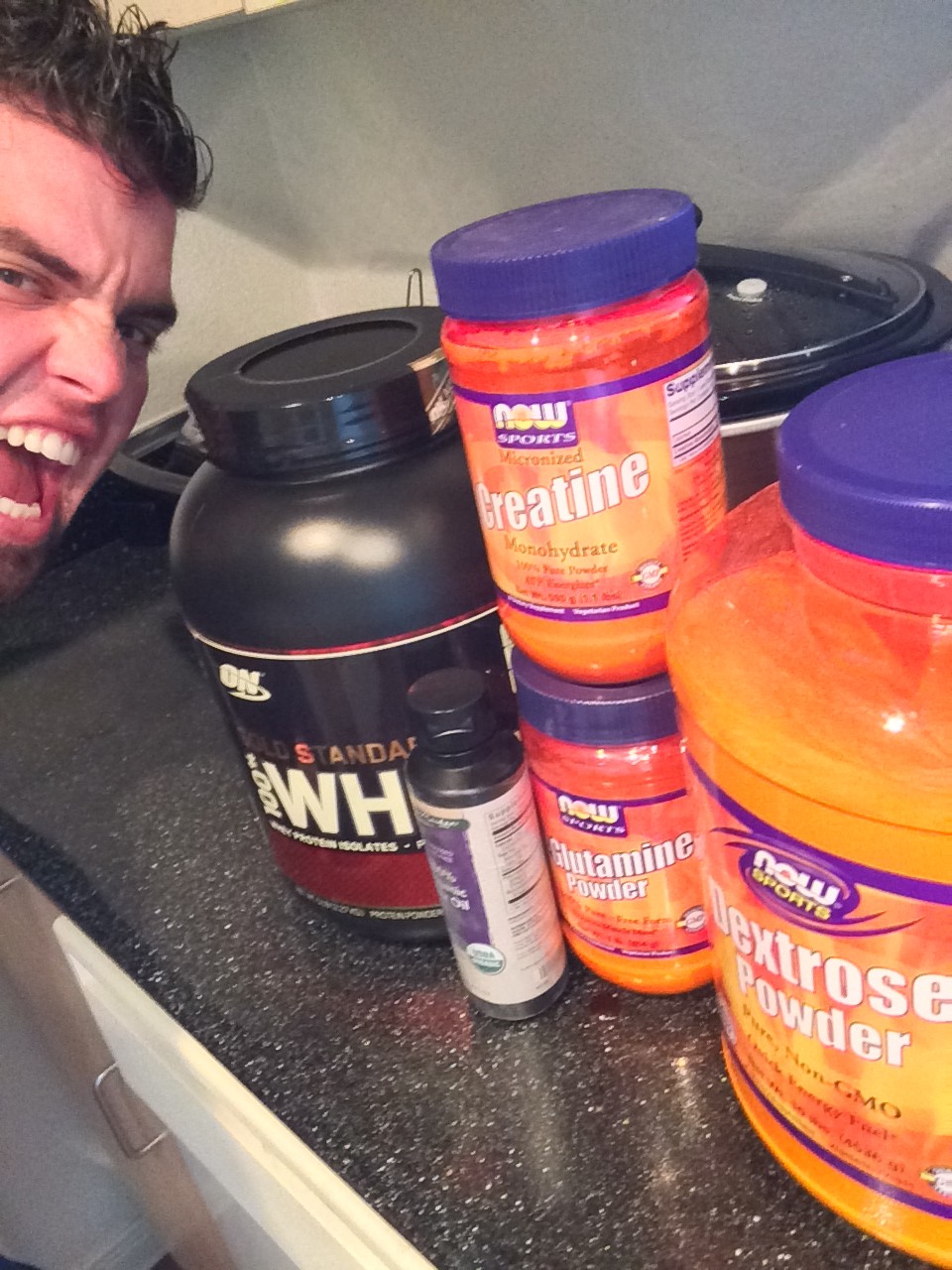
Throwing 95 Miles Per Hour is an incredible athletic achievement. If any baseball player throws a 5 ounces baseball 90+ on the pitches mound, everyone watches with amazement. Reaching 95 Miles Per Hour is less about luck, and more about science.
When I first hit 95 MPH, I knew exactly how I got there. I started off like anyone else. Hoping one day I would throw hard. I hit some obvious plateaus and couldn’t seem to surpass them. This happens to everyone. A plateau is a key indicator of a missing link in your training. Sometimes your missing link is something as simple as sleeping more to aid recovery. For me it was sports nutrition. I optimized every aspect of my nutrient timing. After that everything took off. And my velocity soared past my plateaus.
Through some study of sports nutrition research, I learned that sports nutrition experts have been optimizing what we call the “Power Hormone.” Or as it is more widely used, Insulin.

![]()
Insulin is know as a negative hormone that cause fat creation and decreases fat breakdown. The general public is scared of insulin. And rightfully so. Most people are sedentary. Sit at a desk and stare at a computer. Consistent high levels of insulin have been linked to type 2 diabetes. (This is scary stuff!)
Meanwhile you are lifting, running throwing and moving all the time. Most people do not train like you do. They dont eat like you do. And they dang sure don’t throw like you do. You, baseball pitcher, are an elite athlete.
While it is true that insulin promotes fat synthesis, insulin’s effect on the human body is highly dependent on the human bodies state. Insulin is also an incredible promoter of carbohydrate fuel storage and muscle protein synthesis (the creation of new muscle).
Whether insulin promotes fat synthesis or muscle protein synthesis, is dependent upon which cells are most sensitive to insulin based on their state. Muscle cells are the most insulin sensitive, after exercise. With proper insulin spiking nutrition, studies have show rapid protein synthesis, increased amino acid transport, increased glycogen storage, reduced protein degradation, increased glucose uptake and suppressed cortisol levels. Which leads to the latest advancements in athletes. This is how I overcome fastball velocity plateau.
![]()
Every athlete has experienced this. It is called the “Plateau Problem.” It goes like this…
You are training hard. You see moderate gains in strength, endurance and power output. Then it happens….
Your progress slows down. You stop getting stronger, and your fastball hits a “peak velocity.” At this point you try harder and push more and maybe even change your pitching mechanics. But still you see no strength gains and no increase to your fastball velocity.
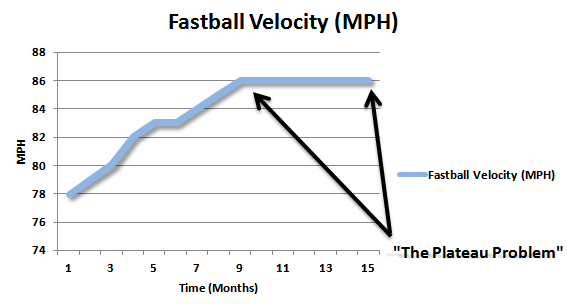
Example Fastball Plateau Chart
Does this remind you of anyone? Yea it does. I was there once too.
Most coaches and players chalk this problem up as “reaching full athletic potential.” Guess what, they are wrong, dead wrong…

When I started to implement the newest sports nutrition research based on measurements, timing and hormone manipulation, everything changed. I recovered faster between workouts. I started to lift heavier weight with no problems. And most of all, my fastball started to boost past my previous plateau. I was throwing faster than I ever dreamed.
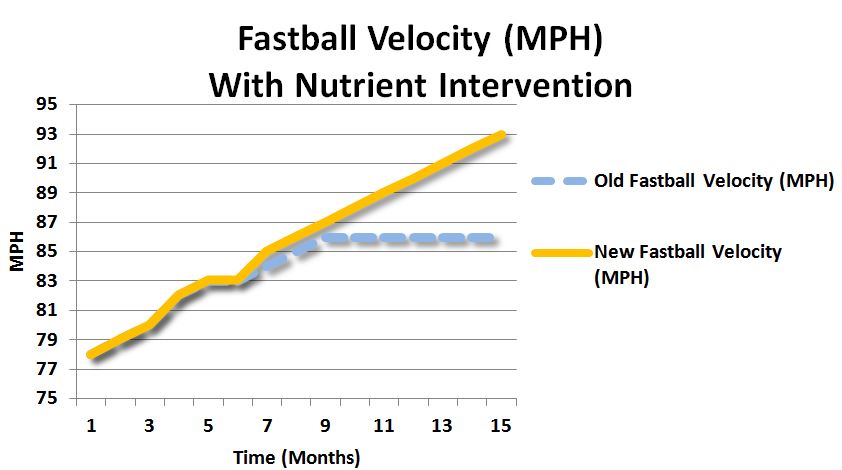
Example Of Zach’s Progress With Nutrient Intervention
It was incredible. “This may be the secret to every athlete’s success.” I thought… Making good players great. And great players, super stars.
 Sports Nutrition has a major problem. This great research has an inability to reach the people that matter the most, the pitchers and athletes. The dugout and weight room is full of hard working baseball players who have no clue the importance of nutrient intervention. The groundbreaking research, that changes the world, never makes it to the brain of the baseball pitcher. This is a BIG problem!
Sports Nutrition has a major problem. This great research has an inability to reach the people that matter the most, the pitchers and athletes. The dugout and weight room is full of hard working baseball players who have no clue the importance of nutrient intervention. The groundbreaking research, that changes the world, never makes it to the brain of the baseball pitcher. This is a BIG problem!
The typical goal of a sports nutrition study is to get published. The unfortunate truth is, that is where it ends. The best and brightest sports nutrition research does not reach past the community of doctors, researchers and experts.
Meanwhile, the most important person, the athlete, has never heard of this ground breaking research. You are left in the dark to relay on rumors you “heard somewhere”.
Here is three examples of published studies you have never heard of:
1) Zawadzki, K.M., Yaspelkis, B.B., III, and Ivy, J.L., “Carbohydrate-protein complex increases the rate of muscle glycogen storage after exercise,” Journal of Applied Physiology, 72:1854-1859, 1992. 2) Levenhagen, D.K., Carr, C., Carlson, M.G., et al., “Post exercise protein intake enhances whole-body and leg protein accretion in humans,” Medicine and Science in Sports and Exercise, 34:828-837, 2002. 3) Gleeson, M., Lancaster, G.I., and Bishop, N.C., “Nutritional strategies to minimize exercise induced immunosuppression in athletes,” Canadian Journal of Applied Physiology, 26(Suppl):S23-S35, 2001.With published research studies like these…
“Shouldn’t our weight rooms, training facilities, dugouts and kitchens look radically different?”
There should be adequate supply of protein and carbohydrates in every training facility. Athletes should be caring around proper supplements in the proper dosage. You should be tracking and measuring your protein intake everyday. And most importantly, elite athletes should know exactly why they are consuming what. Pitchers should not be guessing.
But most baseball pitchers are far behind this career changing research. The research itself is written in a way so it can be communicated only among the research community.
The average Joe who wants to throw harder sooner wont understand the theories being tested and how it can help them immediately.
The unfortunate truth, the original purpose of the study “to benefit the athlete” is lost somewhere. Meanwhile the baseball world is stuck in its old ways. Wondering how the “Major Leaguers” stay so consistent, and keep throwing hard.
 The answer to these problems, is nerds like me. Who not only read and understand the research, but have done it.
The answer to these problems, is nerds like me. Who not only read and understand the research, but have done it.
I have seen results from applying the the latest research of sports nutrition to my career and my life. These groundbreaking studies propelled my fastball from 85 to 95 Miles Per Hour.
You can learn about the nutrition system I created specifically to help pitchers throw harder in less time here: The Throw Cheese Nutrient System
Read More about how I developed the Throw Cheese Nutrient System -click here
Velocity Pillar 5- A Incredibly Strong, Mobile and Health Posterior Cuff
How to throw everyday, feel great and stay healthy.
Earlier I mentioned throwing everyday as a key aspect to your throwing program. So how is that possible?
Well throwing itself is definitely the most sports specific training you can do for baseball. It will absolutely help you throw faster and gain pitching athleticism.
But what happens when you get sore? Most pitchers stop throwing and take a couple days off. When they feel good again, they throw. Here is the deal…that approach to throwing is a sure fire way to progress slowly. You have to throw everyday, at least a little.
Here is what you must do…
Build a strong a mobile posterior cuff. The back side of your rotator cuff. When you have a well developed rotator cuff, your recovery will be faster and your shoulder health will increase. As you develop a stronger posterior cuff, you will notice you can throw for a longer period of time, and throw max effort more days in a row.
After awhile, shoulder health isn’t a concern. You will just be asking, how fast can I get to the next level?
This is the conversation I want for you. But it takes diligent work with an exact custom routine for your shoulder as a elite pitcher.
That is why I created the Rubber Arm Series. Its a 6 week rotator cuff training course full of 30+ videos and 4 reference guides to ultimate shoulder mobility, health and strength. Once you develop your posterior cuff to an elite level, there is no limit to your success. Click below to read more.
The Rubber Arm Series
A 6 Week Training Course For Rotator Cuff Strength, Mobility and Velocity
Learn the exact steps to achieve consistent rotator cuff durability, strength and health. Through 33 videos among 3 courses.
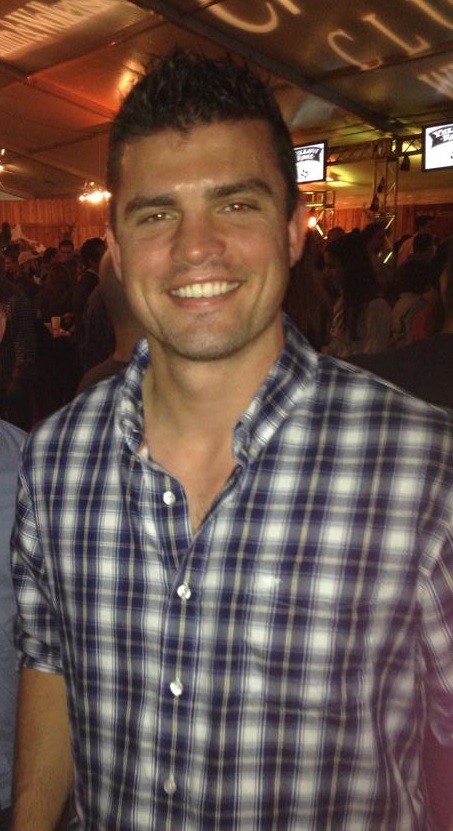
Zach Calhoon
Who Is Zach Calhoon?
Zach Calhoon is the creator and lead writer of PitchersThrowCheese.com. You can learn his story here. He was a pitcher for The University of Texas at San Antonio. He entered the program throwing 86 mph. By his junior year in college he threw 95 mph. With great physical training and practical research, he had a great career at UTSA.. He holds the record for most saves in Southland Conference history. He was an All American, won 2 conference championships and set the single season saves record for UTSA. Zach credits his success to sports nutrition study and hard work. Now he is writes and teaches everything hes learned through pitchersthrowcheese.com.
Some Articles about Zach:
It is important to note that Zach is not a Doctor, or does he pretend to be one. “My passion is to educate the pitching world the best I can. I truly believe I can help young pitchers all over the world. Thank for coming to my site.”
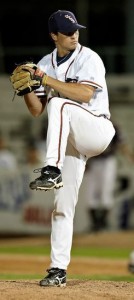
Zach Calhoon in 2008
“Throwing 95 mph is an incredible feeling, I want you to throw gas. Work hard, study hard. Welcome to PitcherThrowCheese.com.” -Zach

